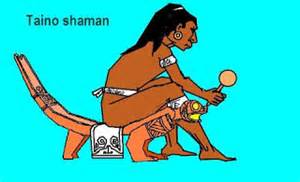The common Taíno family consisted of a man, woman, and 2-3 children. Females and males had different roles, yet equal rights. Women provided the labor for agriculture, while men hunted and fished off coast. The Taíno traced their decent maternally (mother’s side)- a man lived in his maternal village, and any goods, status, or office were inherited through maternal linage.
Women worked in the fields with their babies on their backs. Daughters helped their mothers prepare the manioc. It was during these times when girls would learn the women’s songs, stories and traditions of their people. Other jobs women had included working with clay, designing pottery, and making beautiful jewelry. Women were also responsible for picking and weaving cotton into hammocks, baskets, and white skirts worn by married women, called naguas.
Men, on the other hand were responsible for tasks such as building canoes, using fire, falling trees, and making tools from stone. They would also find gold to be used in jewelry from the riverbeds and streams. Fathers and extended male family members taught boys the ways of fishing and hunting.
During religious ceremonies, the Bohique (a medicine person or shaman) taught the history of the Taínos. Through stories and song, the Bohique passed down knowledge of their villages, battles, historical events, and taught religion and tradition.
Written language was in the form of carving symbols on rocks, while oral history was passed down through songs, dance, and stories. Children learned how to play instruments from an early age and were actively engaged in these ceremonies.
(Rouse, 1992; Jacobs, 1992)


